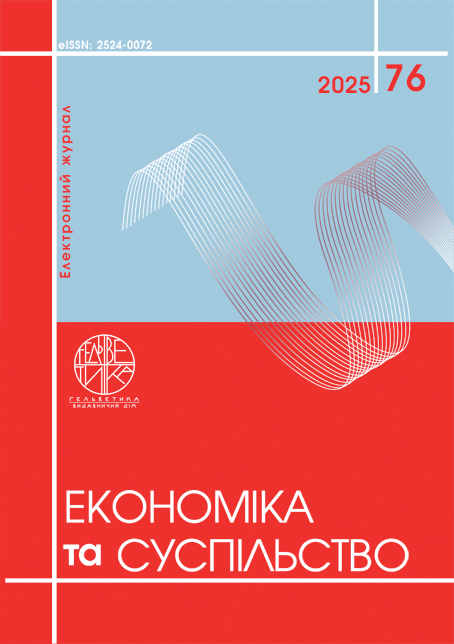MATHEMATICAL MODELING OF THE BALANCE OF DEMAND AND SUPPLY ON THE LABOR MARKET OF UKRAINE IN THE CONDITIONS OF LABOR MIGRATION AND DIGITAL TRANSFORMATION
Abstract
The article examines the current state and trends in the development of the Ukrainian labor market in the context of open armed aggression lasting more than three years, mass labor migration, digital transformation of the economy, and growing destructuring of employment. It is emphasized that under the influence of internal and external factors, a complex socio-economic environment is being formed in Ukraine, in which new challenges arise: a shortage of qualified personnel, structural unemployment, a reduction in the economically active population, an imbalance between demand and supply of labor. A significant part of the working-age population migrated abroad or joined the Armed Forces of Ukraine, and the introduction of digital technologies has changed the nature of professions and the structure of employment. Analysis of modern mathematical tools and methods used at the present stage to assess the labor market in Ukraine, such as statistical analysis, regression analysis, supply and demand models, allowed the formation of a new mathematical model of balancing demand and supply in the labor market. The proposed mathematical model of balancing supply and demand in the labor market is formed taking into account the level of digitalization of the economy, destructuring of employment and the growth of the role of women in labor activity. The model uses a systematic approach that includes calculating labor supply based on demographic and social parameters, as well as demand – taking into account the impact of industry 4.0, automation and flexible forms of employment. The model is implemented for the forecast period of 2025–2030 and allows you to assess the balance in the labor market, imbalances associated with regional, gender and technological factors. Based on the results of the calculations, linear and bar graphs were formed that illustrate the dynamics of demand, supply and potential development scenarios. It was established that in order to effectively respond to the challenges of the labor market, it is necessary to systematically implement state policies aimed at digital education, retraining of personnel, support for female employment and control over labor migration.
References
Васильєва О.О., Горошкова Л.А., Швидка С.П. Дисбаланс ринку праці України: сучасні тенденції та орієнтири подолання диспропорцій. Економічний вісник університету. Ун-т Григорія Сковороди в Переяславі. 2023. Вип. 57. С. 99-109. URL: http://nbuv.gov.ua/UJRN/ecvu_2023_57_15
Вільчинська, О.О. дослідження факторів впливу на ринок робочої сили за допомогою економетричного моделювання. Економіка та суспільство. 2024. № 62. DOI: https://doi.org/10.32782/2524-0072/2024-62-169.
Касьяненко В.О., Старченко Л.В. Моделювання та прогнозування економічних процесів. Київ : Університетська книга, 2023. 185 с.
Новини ринку праці. Work.ua — сайт пошуку роботи №1 в Україні. URL: https://www.work.ua/news/ukraine/?page=2
Прімєрова О.К., Спаріш А.І. Моделювання ринку праці України: системно-динамічний підхід. Наукові записки НаУКМА. Економічні науки. 2024. № 9(1). . 80–86. DOI: https://doi.org/10.18523/2519-4739.2024.9.1.80-86
Ринок праці. Державна служба статистики України. 2025. URL: https://www.ukrstat.gov.ua/
Степура Т.М., Дідух Н.М., Дериколенко О.М., Дегтярьова І.Б. Цифрові розриви ринку праців умовах індустріальних змін і цифровізації економіки. Mechanism of an economic regulation. 20252(104). Р. 7-17. URL: https://www.researchgate.net/publication/388313450_CIFROVI_ROZRIVI_RINKU_PRACI_V_UMOVAH_INDUSTRIALNIH_ZMIN_I_CIFROVIZACII_EKONOMIKI
Трудові ресурси для повоєнного відновлення України: стан, проблеми, шляхи розв’язання. Аналітична доповідь Центру Разумкова, 2024. URL: https://razumkov.org.ua/images/2024/10/16/2024-Pyshchulina-TRUDJVI-RESURS-UKR-SAIT.pdf
Vasylyeva, O.O., Horoshkova, L.A., & Shvydka, S.P. (2023). The imbalance of the labor market in Ukraine: current trends and guidelines for overcoming disproportions. Economic Bulletin of the University, Hryhorii Skovoroda University in Pereiaslav, 57, 99–109. Available at: http://nbuv.gov.ua/UJRN/ecvu_2023_57_15
Vilchynska, O.O. (2024). Research of factors influencing the labor market using econometric modeling. Ekonomika ta suspilstvo – Economy and Society, 62. DOI: https://doi.org/10.32782/2524-0072/2024-62-169
Kasiianenko, V.O., & Starchenko, L.V. (2023). Modeliuvannia ta prohnozuvannia ekonomichnykh protsesiv [Modeling and forecasting of economic processes]. Kyiv: Universytetska knyha. 185 p.
Work.ua. (n.d.). News of the labor market. Ukraine’s No. 1 job search website. Available at: https://www.work.ua/news/ukraine/?page=2
Primierova, O.K., & Sparish, A.I. (2024). Modeling the labor market of Ukraine: a system-dynamic approach. Naukovi zapysky NaUKMA. Ekonomichni nauky – Scientific Notes of NaUKMA. Economic Sciences, 9(1), 80–86. DOI: https://doi.org/10.18523/2519-4739.2024.9.1.80-86
State Statistics Service of Ukraine. (2025). Labor Market. Available at: https://www.ukrstat.gov.ua/
Stepura, T.M., Didukh, N.M., Derykolenko, O.M., & Dehteriova, I.B. (2025). Digital gaps in the labor market in the conditions of industrial changes and economic digitalization. Mechanism of an Economic Regulation, 2(104), 7–17. Available at: https://www.researchgate.net/publication/388313450
Razumkov Centre. (2024). Labor resources for Ukraine’s post-war recovery: state, problems, ways of solving. Analytical report. Available at: https://razumkov.org.ua/images/2024/10/16/2024-Pyshchulina-TRUDJVI-RESURS-UKR-SAIT.pdf

This work is licensed under a Creative Commons Attribution 4.0 International License.


